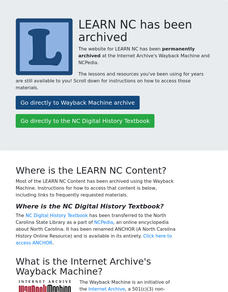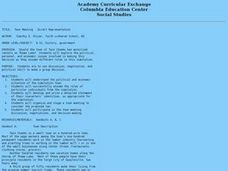Curated OER
How Wet Can You Get?
Learners visit a swimming pool and brainstorm different water sports and what benefits swimming has over other types of exercise. They then discuss buoyancy and water pressure and when how objects sink or float before playing a game of...
Curated OER
Fort Morgan, Colorado - 100 Years of Progress and Promise
Learners discover and practice interviewing skills by role-playing. They utilize these techniques while discussing the history of Fort Morgan with senior citizens who came to the school and with those whom they visited in the local...
Curated OER
What Makes a Dog a Dog
First graders recall and verbally list the parts of a dog, or a chosen subject, based on observations using the senses. They discriminate between living and non-living subjects, and create artistic representations of the parts of a dog.
Curated OER
Town Meeting
Students organize and stage a town meeting. They write a set of discussion guidelines and participate in a political discussion.
Curated OER
Creating Plants
Students create their own plants and write about them using digital cameras, AppleWorks, and the educational program Kid Pix. Emphasis is placed on the creative process and reflective writing.
Curated OER
Replanting the Rainforest
Students practice problem solving techniques. They interpret data gathered by student researchers in Australia about the effectiveness of various strategies for controlling weed growth in a newly replanted rainforest.
Curated OER
Illinois' Habitats Happening
High schoolers use the scientific inquiry method to examine the ecosystems and biomes in Illinois. Using the characteristics of a local habitat, they identify the best conditions for an ecosystem to survive and how a slight change can...
Curated OER
Very Big Company
Students describe the problems of political independence without economic independence. They evaluate the natural resources, human resources and industrial resources of a country and make economic decisions. They evaluate strengths and...
Curated OER
Giving Back
Students research the start of the March of Dimes and discuss the benefits of their actions when contributing to a charity. Students continue the lesson by calculating how much money would have been collected in a week, month, and year...
Curated OER
Hatching Brine Shrimp
Third graders investigate the environment that is considered favorable for brine shrimp hatching. The salinity level is of particular interest in the observations because the optimum level is needed for survival. They make daily...
Curated OER
The Giant Cell
After actively participating in a unit on cells, the students act out and become the organelles. They will act out and explain the functions of what each of the organelles do for the cell.
Curated OER
Wandering Wild-oats
Students observe wild-oat seeds. In this biology lesson plan, students watch how wild-oat seeds react to moisture and draw conclusions and make predictions.
Science Education Resource Center at Carleton College
Serc: Plant Succession Field Investigation
This lesson is to be used as an introduction to ecosystems and plant succession. Students will observe both biotic and abiotic features of a selected site on a plot of wild land. They will take notes, make drawings, and collect samples...
PBS
Pbs Learning Media: Write Now! Career Prompts: Plant Management/financial Affairs
This Career Clip features Frank Sabernowski, Plant Management/Financial Affairs staff member at Bosch-Rexroth Corporation. Frank discusses teamwork and why understanding others is important in producing a successful final product.
Science Buddies
Science Buddies: Project Ides: Propagate Plants Without Using Seeds!
This plant biology science fair project that explores factors involved in successful propagation of plants using plant division instead of seeds. The Science Buddies project ideas are set up consistently beginning with an abstract,...
Ohio State University
Ohio State University: Concepts of Plant Ecology
An advanced discussion of plant interactions and relationships. Energy flow, nutrient cycling and succession are discussed. Try the quiz to check your understanding.
The Wonder of Science
The Wonder of Science: Ms Ls1 4: Animal Behaviors Plant Structures Reproduction
Work samples, phenomena, assessment templates, and videos that directly address standard MS-LS1-4: animal behaviors and plant structures- reproductive success.
Other
Plant Physiology: Mineral Requirements
This page discusses the mineral requirments needed for plants to grow successfully. The website focuses on the soil and the types of soil that creates a loam for individual plant types.
Alabama Learning Exchange
Alex: Field Challenge Strategy Game
Lesson plan describing a strategy game where students use flags in a large field to mimic the growth and spread of trees, grass, and shrubs. Rules for game include how trees, grass, and shrubs interact to compete for sunlight, nutrients,...
Other
Princeton Plasma Physics Laboratory: Fusion Basics
A wealth of background information on nuclear fusion and its potential use as a commercial energy resource. The advantages of nuclear fusion over other resources, the conditions required for its successful implementation and the future...
Alabama Learning Exchange
Alex: Wildlife Math
This integrated lesson is the result of collaboration between Chip Blanton, a wildlife management teacher, and Greg Pendergrass, a math teacher (Ft. Payne High School). Learning to manage wildlife requires an understanding of planting...
CK-12 Foundation
Ck 12: Life Science: Angiosperms
[Free Registration/Login may be required to access all resource tools.] Angiosperms, in the phylum Anthophyta, are the most successful phylum of plants. Angiosperms evolved the structure of the flower, so they are also called the...
National Wildlife Federation
National Wildlife Federation: Organic Practices
How do you eliminate pesticides and fertilizers and still have a viable garden? This comprehensive resource discusses how you can be a successful organic gardener without the use of pesticides and fertilizers. Many helpful hints and tips...
Scientific American
Scientific American: Harness Hydrogen Fuel From Plants
This article, published by Scientific American (August 29, 2002), explores the successful manufacturing of hydrogen from a glucose solution derived from biomass. Such a fuel source, if proven practical, could easily power hydrogen...
























